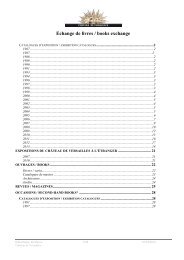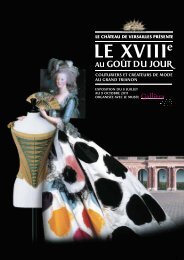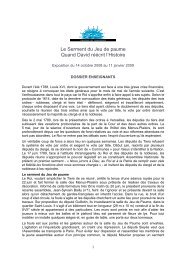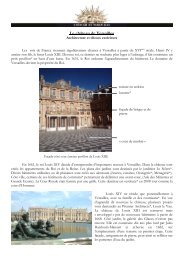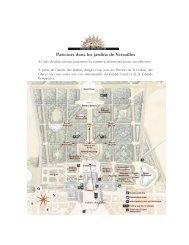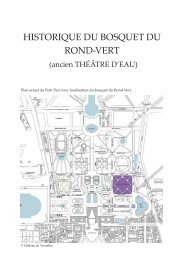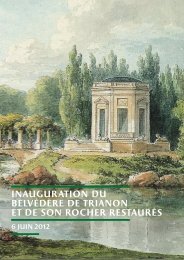DP Opéra anglais .indd - Château de Versailles
DP Opéra anglais .indd - Château de Versailles
DP Opéra anglais .indd - Château de Versailles
You also want an ePaper? Increase the reach of your titles
YUMPU automatically turns print PDFs into web optimized ePapers that Google loves.
22<br />
GLOSSARY<br />
Apron<br />
Sect ion of the st age fl oor that project s outwards<br />
into the auditorium. In proscenium theatres, the<br />
part of the st age in front of the curtains or the<br />
proscenium arch.<br />
Centre line<br />
An imaginary line dividing the st age down the<br />
middle into two equal parts.<br />
Curtains<br />
Movable vertical panels on either si<strong>de</strong> of the<br />
st age opening used to «open» or «close» the<br />
si<strong>de</strong>s of the st age frame <strong>de</strong>pending on need. Th e<br />
curtains are topped by the tormentor, which<br />
horizontally follows the same principles.<br />
False grid<br />
A st ruct ure over the grid housing some of its<br />
equipment (pulleys) in or<strong>de</strong>r to facilitate<br />
circulation.<br />
Flyloft<br />
Th e part of the theatre located above the st age,<br />
which inclu<strong>de</strong>s the:<br />
- services on either si<strong>de</strong> of the st age<br />
- catwalks connect ing the services<br />
- grid above the whole thing.<br />
Th e i<strong>de</strong>al fl yloft should be more than twice the<br />
height of the proscenium arch, in or<strong>de</strong>r to hi<strong>de</strong><br />
the scenery.<br />
Forest age<br />
Th e front of the part of the st age closest to the<br />
audience.<br />
Foyer<br />
Th e part of the theatre the audience enters when<br />
arriving at the theatre. Th e word «foyer» means<br />
«hearth» in French. Prior to the 18th century the<br />
only heated part of a theatre was the entrance<br />
area, where the audience could go to warm up in<br />
front of a fi re between act s. Th e hearth vanished<br />
long ago but the sp ace is st ill known as the foyer.<br />
Grid<br />
Area over the st age housing the machinery’s<br />
rigging and superst ruct ure. Th e grid is a<br />
framework of beams approximately 10<br />
centimetres thick with openings approximately<br />
fi ve centimetres wi<strong>de</strong> through which cables,<br />
wires and lines pass. Th e crossbeams are sp aced<br />
one every meter.<br />
Lambrequin<br />
A st ationary ornamental bor<strong>de</strong>r in front of the<br />
apron curtain. Th e lambrequin adds to the<br />
auditorium’s st yle and architect ure and hi<strong>de</strong>s the<br />
lower part of the apron curtain when it is up.<br />
Proscenium<br />
Th e part of the st age between the curtain line<br />
and the audience.<br />
Proscenium arch<br />
Th e opening in the wall that st ands between the<br />
st age and auditorium; the «pict ure frame»<br />
through which the audience sees the<br />
performance. Th e movable opening of the st age<br />
formed by adjust able elements (curtains and<br />
tormentor) are located behind this frame.<br />
Si<strong>de</strong>s<br />
Th e gar<strong>de</strong>n si<strong>de</strong> is the left si<strong>de</strong> of the st age for the<br />
audience and the courtyard si<strong>de</strong> is the right si<strong>de</strong>.<br />
In the 17th century, looking out from the st age<br />
and into the auditorium, the King’s loge was on<br />
the right-hand si<strong>de</strong> and the Queen’s loge was on<br />
the left -hand si<strong>de</strong>. Th e right si<strong>de</strong> was therefore<br />
called the «King’s si<strong>de</strong>» and the left si<strong>de</strong> the<br />
«Queen’s si<strong>de</strong>». In 1792 the Revolution abolished<br />
everything that might remind people of the<br />
monarchy. Th e right si<strong>de</strong> (the King’s si<strong>de</strong>)<br />
became known as the «gar<strong>de</strong>n» si<strong>de</strong>, aft er the<br />
Tuileries Gar<strong>de</strong>n, and the left si<strong>de</strong> (the Queen’s<br />
si<strong>de</strong>) as the «courtyard» si<strong>de</strong> because of the<br />
Carrousel courtyard.



